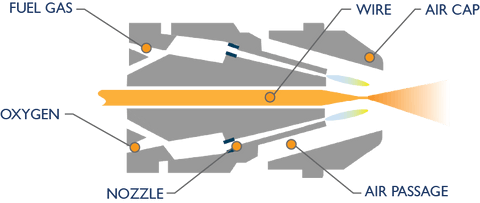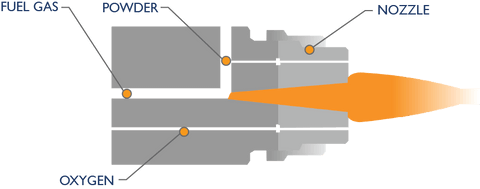What is Flame Spray?


Flame Spray utilizes the high-temperature flame generated by combusting gases (typically acetylene, propane, hydrogen, or natural gas mixed with oxygen) to melt the spraying material (either metal wires or powders). The molten material is then atomized using high-pressure gas and sprayed onto the substrate surface at high speed. In comparison to High-Velocity Oxygen Fuel Spray, Flame Spray offers simpler equipment and easier operation, albeit at lower spraying temperatures and velocities.
| Operating Cost | Economical |
| Bond Mechanism | Mechanical (1,000-5,000 psi) |
| Max Flame Temperature | 5,600° F |
| Particle Velocity | 160-300 ft/sec |
| Max Spray Rate | 20 lbs/hr |
| Coating Thickness Range | 0.005″ to 0.250″ |
| Special Features | Economical, no heat distortion |
| Wear Resistance | Acceptable |
| Corrosion Resistance | Poor to Medium |
| Porosity | High |
Key Features of Flame Spray Technology:
- Material Diversity: Flame Spray supports a variety of coating materials, including metals, alloys, ceramics, and other composite materials, catering to different protection requirements such as heat resistance, corrosion resistance, wear resistance, and thermal insulation.
- High Adaptability: Suitable for coating most product surfaces, excluding very small pores, regardless of their shapes.
- Excellent Wear Resistance: Flame-sprayed coatings exhibit high surface hardness, and the micro-porous structure of the coatings can adsorb lubricating oil, reducing surface friction and damage.
- Minimal Impact on Substrate: The heating zone temperature on the substrate surface is typically 200-250°C, with an average substrate temperature of 70-80°C, resulting in low thermal damage to the substrate.
- Moderate Coating Adhesion: Due to lower bonding temperatures, Flame Spray coatings have moderate adhesion strength and cannot withstand strong impacts and loads. Additionally, the quality of the coatings is not easily detectable.
- Higher Surface Requirements: Flame Spray demands higher surface quality for the substrate to achieve optimal results.
Flame Spray was one of the earliest thermal spraying techniques and, with continuous technological innovations, has found widespread applications across various industries. It is commonly employed as a protective method for large steel structural components, offering versatile solutions in numerous sectors.
